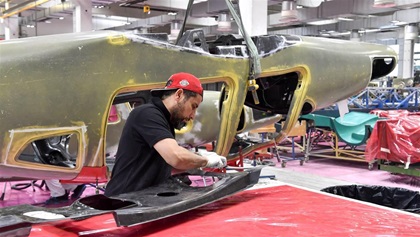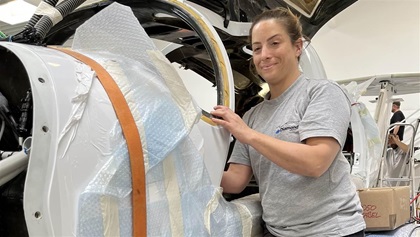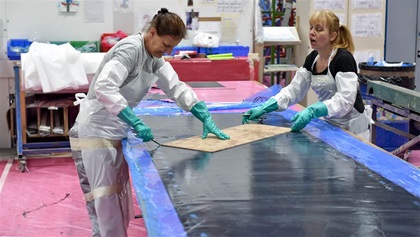Diamond DA50 RG: V-6 shakeup
Big inside and out, it’s everything its predecessors aren’t

By 2004, it expanded its offerings to twins with the debut of the Thielert Centurion diesel-powered DA42 Twin Star line; it started making its own Austro line of turbodiesel engines in 2007; and followed up in 2012 with the larger, seven-seat Austro-powered DA62. Along the way came the D-Jet, a 2006 twinjet design intended to capitalize on what at the time seemed like a vast market for very light jets. Today, all the aircraft are still in production (save the D-Jet) and selling well to both private owners and flight schools around the world. That’s quite a product line, but Diamond lacked a big-cabin single that could one-up the DA40.
Details






Until the DA50 RG came along in 2020. It was a long time coming, with the first DA50 prototype appearing in 2007. But after trials with no fewer than six different engines (a turbocharged piston, a turboprop, and four diesels) and a switch to retractable landing gear, the first DA50 RGs were sold to European customers in 2021. By this summer, the DA50 RG should have earned its FAA certification and begun a demonstration tour in the United States.
Systems basics
The airplane has a 300-horsepower Continental CD-300 dual-channel full authority digital engine control, intercooled twin turbo turbo-diesel engine, liquid cooled and arranged in a V-6 configuration. Fuel is fed to injectors at the pistons via a dual common rail fuel injection system that operates at 23,000 psi thanks to high-pressure fuel pumps. The FADEC controls ensure that the proper amount of fuel is delivered to each cylinder at the proper time, ensures that no limitations are exceeded, and controls the turbochargers and propeller, which is driven through a gearbox.
With all that fuel pressure there’s no way the engine can consume the volume of fuel being fed into the cylinders. So, the unused fuel is returned to the main and auxiliary fuel tanks. Along the way, the heat of the returning fuel is cooled on its way to the left (main) tank, while warm fuel returning to the right (auxiliary) tank keeps fuel temperatures from reaching the freezing point at altitude. In another quirk, fuel is normally delivered to the engine from the main tank only, so there’s a fuel-transfer rotary button to send fuel from the aux tank to keep fuel tank imbalances below the 9-gallon limit. If there’s a problem with the fuel feed from the left tank, fuel can be drawn from the aux tank by moving the fuel selector to the Emergency position.
Thanks to the automated functions of the FADEC, a single-lever power control governs both engine and propeller functions, so there’s no need for separate propeller and mixture controls. A small sliding switch at the front of the power lever controls rudder trim; slide left or right to trim out rudder forces, and be sure to trim to the right for takeoffs and go-arounds.
...and more details






That’s about it for the differences that most of us would encounter. Except maybe the front seats. As in other Diamond aircraft, they don’t adjust fore and aft because they’re joined to the wing spar box and the flexible crush mounts that make the seats able to withstand 26-G impact forces. Instead, an electrical switch moves the rudder pedal assembly to suit your leg length. And, sure, there are dual alternators and FADECs, but you’d expect these on any digitally controlled powerplant. And for high-altitude flying there’s an oxygen system that uses nasal cannula. The airplane’s maximum operating altitude is 20,000 feet, and Diamond says it reaches its fastest, 181-knot true airspeed at 16,000 feet.
A full-boat cross-country
So, what’s it like to fly the apex Diamond single? Lucky me, at this year’s Aero Friedrichshafen trade show I had a chance to fly the display DA50 RG back to the Diamond factory at Austria’s Wiener Neustadt East Airport (LOAN). With Martin Scherrer, Diamond’s head of flight operations and flight training, chief pilot, and chief flight instructor, in the right seat; my wife, AOPA Pilot magazine Media Production Specialist Sylvia Horne, and photographer Mark Wagner in the backseats; plus luggage that filled the cavernous baggage area behind the rear seats, our payload was a whopping 838 pounds. Add in 40 gallons of Jet A and we were right at the maximum takeoff weight of 4,407 pounds.
With such a maxed-out airplane, I wondered how sprightly the takeoff might be. There was no need to worry.
Engine start, like most everything else, is simple. FADEC switch on Auto, engine master On, alternators 1 and 2 On, electric master On, check that the Garmin G1000 NXi shows a glow plug On (it’s a diesel, remember?), then Off annunciation, and push the starter button. After the CD-300 comes to life, check the FADEC channels, wait until the oil, coolant, and gearbox temperatures rise into their green arcs, and you’re ready to taxi.
With such a maxed-out airplane, I wondered how sprightly the takeoff might be. There was no need to worry. Scherrer had me stand on the brakes and push the power to the max, and it was all I could do to keep OE-VTW from bolting. So away we went, accelerating to the 70-knot VR and lifting off into a 900-fpm climb at the 80-knot VY. Pretty good for a maxed-out airplane.
The ceiling at Friedrichshafen was 3,000 broken, and the forecast for the trip along the north edge of the Alps was for layers up and beyond our filed 11,000-foot cruise altitude. The freezing level was around 6,000 feet, and icing was definitely in the picture along the entire route. Good thing we had the optional TKS “weeping wing” ice protection system aboard; I used the Garmin GFC 700 for pretty much the entire climb and cruise, with one eye on the outside air temperature (OAT) and the other on the cloud situation. Luckily, we stayed between layers most of the time.
ATC had us level off at 8,000 feet for a while, so I took some notes. Power was set to maximum continuous, shown as the 90-percent limit on the load gauge (there’s no manifold pressure readout), and we saw 165 KTAS burning 15.3 gph. After levelling at 11,000 feet and setting the recommended power setting of a 75-percent load, we still saw 168 KTAS—having picked up some true airspeed at altitude—but fuel flow dropped to 12.7 gph. This was at an OAT of minus 9 degrees Celsius/international standard atmosphere minus 2 degrees C. Scherrer said that if we pulled the power back to a long-range cruise, 50-percent load we’d see 142 KTAS on a fuel burn of 8.8 gph
The Iridium datalink weather (SiriusXM Aviation weather isn’t available in Europe) showed some yellow contours at one point, and when we entered the area, we saw the first traces of ice. By this time, Wiener Neustadt East was near and we were cleared for a descent. On the way down to shoot the LNAV approach, all the ice was shed and as we descended, we went through snow, then rain as we left the overcast at 5,000 feet.
A turn around a holding pattern at 100 knots, and it was down final at 80 knots with gear down and landing flaps. A decent flare, a low-impact touchdown, and we were home—well, Diamond’s home. Total trip distance and time: 289 nautical miles and one hour, 55 minutes. Fuel reserves on landing: nine gallons, or 45 minutes’ worth of endurance.
The DA50 RG is presumably meant as a challenger to high-performance piston singles such as the Beechcraft Bonanza G36 or Cirrus SR22, or as an upgrade option for those owning older airplanes who yearn for modern technology and edgy looks. Whatever the appeal, Diamond is confident. It expects 300 total sales in 2022, rising to 500 aircraft in 2024, with a 50-50 split between private owners and fleet operators such as flight schools.
Whatever the appeal, Diamond is confident. It expects 300 total sales in 2022, rising to 500 aircraft in 2024, with a 50-50 split between private owners and fleet operators such as flight schools.As for the top of the line, Diamond has said there will be special focus on the DA62 and DA50 RG. The company says the DA50 RG engine’s time between replacement (there is no time between overhaul) extension to 2,000 hours will help sales. There are other signs of optimism. Diamond’s Chinese owners—Wanfeng Aviation—say they’re building a new factory in Qingdao, China, to help ramp up production, joining the existing factories in London, Ontario, and Wiener Neustadt. An aerobatic trainer—the Dart 750—is also in the works, as is the eDA40, a hybrid-electric design.
The snarky among us might complain about the DA50 RG’s somewhat heavy roll forces or modest range, or poke fun at that smallish fifth, center seat. But vortex generators and slotted Fowler flaps mean docile stalls and little in the way of low-speed airflow separation over the wings, and the VGs provide roll control even as the airplane is deep in the stall. As for its 750-nm maximum range, most pilots seldom fly legs this long. And there’s no arguing about the airplane’s interior room and comfort.
The last day of our visit, Scherrer gave us a tour of the nearby Alps, where we flew around one snow-covered peak after another, then flew down a narrow, sinuous valley he called the “Valley of Hell,” banking steeply as we wended our way through. Seems this is part of every demo ride conducted out of Wiener Neustadt, and the DA50 RG’s nimble maneuvering down the valley showed off just one of the airplane’s many attributes. It will be interesting to see how the market responds to this remarkable airplane. Its price will be one factor, and as of this writing Diamond has said that average-equipped DA50 RGs will go for about $1.3 million.






